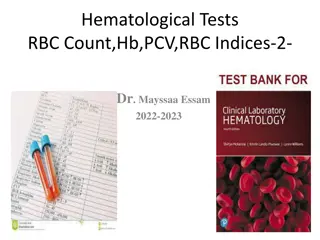Understanding Packed Cell Volume (PCV) and Hematocrit in Blood Testing
Packed cell volume (PCV) is a measure of the percentage of blood volume occupied by red blood cells (RBCs), used to screen for anemia and calculate hemoglobin concentration. Also known as hematocrit (HCT), it falls within specific ranges for adult males and females. The PCV is determined from venous or capillary blood samples using a microhematocrit centrifuge. Factors like inclusion of buffy coat or hemolysis can affect accuracy. The PCV relates to the hemoglobin level in a 1:3 ratio and can vary with different types of anemia. Screening errors should be considered for reliable results.
Download Presentation

Please find below an Image/Link to download the presentation.
The content on the website is provided AS IS for your information and personal use only. It may not be sold, licensed, or shared on other websites without obtaining consent from the author. Download presentation by click this link. If you encounter any issues during the download, it is possible that the publisher has removed the file from their server.
E N D
Presentation Transcript
Packed Packed cell defined as the percentage of the volume occupied by RBC to the whole blood volume. The The packed packed cell cell volume volume (PCV) (PCV) can simple screening test for anaemia, The PCV is about three times the Hb expressed in g/dl. Therefore can be used to calculate Hb concentration It can be used in the calculation of red cell indices. cell volume volume (PCV) (PCV) also also called called hematocrit hematocrit (HCT) (HCT) is can be be used used as: : Normal Normal Ranges Adult males = (40% - 52%) Adult females = (37% - 47%) Ranges
Hematocrit Hematocrit Method Test Test Sample Sample Anticoagulated venous blood (k2EDTA is recommended, k3EDTA cause RBC shrinkage) or capillary blood. Equipment Equipment Micro haematocrit centrifuge 75 mm long capillary tubes with an internal diameter of 1 mm. (blue plain capillary with Anticoagulated venous blood and red heparinized capillary tube for the direct collection of capillary blood). Plastic sealer or Bunsen burner. haematocrit reader Procedure Procedure Blood samples should be as fresh as possible and well mixed. 1. Using a capillary tube, allow blood to enter the tube by capillary action fill the 3/4capillary tube leaving about 1_1.5 cm un filled from one end. Wipe the outside of the tube. 2. Seal the end by pushing into plastic seal two or three times. If heat sealing is used, rotate the dry end of the tube over a fine Bunsen burner flame. 3. Place the tube into one of the centrifuge plate slots, with the sealed end against the rubber gasket of the centrifuge plate. Keep a record of the patient number against the centrifuge plate number. 4. Centrifuge for 5 minutes. This separates the RBCs from plasma and leaves a band of buffy coat consisting of WBCs and platelets. Method
5. Read the PCV in the micro haematocrit reader. The haematocrit result is expressed in a percentage.
Biologic Biologic sources If the buffy coat is included in the RBCs when reading the result, the PCV will be falsely elevated. Hemolysis of the specimen can cause a falsely decreased result. When the microhematocrit is spun for the correct time period and at the proper speed, a small amount of plasma still remains in the red blood cell portion. This is termed trapped plasma. An increased amount of trapped plasma is found in macrocytic anemia, spherocytosis, thalassemia, hypochromic anemia and sickle cell anemia. The approximate relationship of the hemoglobin level to hematocrit is 1:3 ( 2), a ratio that may vary with the plasma volume and the cause of the anemia and the effect of that cause on the RBC indices, particularly the mean corpuscular volume (MCV). sources of of error error: :























